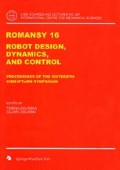Abstract
We describe how human equilibrium control principles, which were derived from neurophysiological experiments, can be implemented in a biped humanoid robot (‘PostuRob’). Stance control in humans uses sensorbased feedback which involves mainly three sensors that measure: (1) body motion in space (vestibular system), (2) body motion with respect to the feet (ankle angle proprioception), and (3) torque between body and feet (ankle torque proprioception). The sensor signals are not used directly for feedback, but instead are used to internally reconstruct the physical stimuli in the outside world by means of sensor fusions. These reconstructions yield internal estimates of the external force fields such as gravity, the external contact forces (e.g. push), and support surface motion. The estimates are fed into an ankle angle proprioceptive feedback loop. By way of the signal fusions the robot’s control adjusts to the external stimulus situations, a fact that allows for low loop gain and robust control. This control differs from that of the biped robots described in the literature. They tend to use a global stability measure such as the COP (centre of pressure) or ZMP (zero moment point) and this control does not adjust to the external stimulus situation. Our PostuRob is used in a biorobotics approach to better understand stance control deficits of neurological patients and the effects of therapy and rehabilitation.
Access this chapter
Tax calculation will be finalised at checkout
Purchases are for personal use only
Preview
Unable to display preview. Download preview PDF.
Bibliography
Duysens J, Clarac F, Cruse H (2000) Load-regulating mechanisms in gait and posture: comparative aspects. Physiol Rev 80:83–133
Maurer C, Mergner T, Bolha B, Hlavacka F (2000) Vestibular, visual, and somatosensory contributions to human control of upright stance. Neursci Let 281:99–102
Maurer C, Mergner T, Peterka RJ (2005) Multisensory control of human upright stance. Exp Brain Res (DOI 10.1007/s00221-005-0256.y)
Mergner T (2002) The Matryoshka Dolls principle in human dynamic behavior in space-A theory of linked references for multisensory perception and control of action. Curr Psychol Cogn 21:129–212
Mergner T, Glasauer S (1999) A simple model of vestibular canal-otolith signal fusion. Ann New York Acad Sci 871:430–434
Mergner T, Huber W, Becker W (1997) Vestibular-neck interaction and transformations of sensory coordinates. J Vestib Res 7:119–135
Mergner T, Maurer C, Peterka RJ (2003) A multisensory posture control model of human upright stance. In: Prablanc C, Pélisson D, Rossetti Y (eds) Neural control of space coding and action production. Progr Brain Res 142:189–201
Mergner T, Nasios G, Maurer C, Becker W (2001) Visual object localization in space. Interaction of retinal, eye position, vestibular and neck proprioceptive information. Exp Brain Res 141:33–51
Peterka RJ (2002) Sensorimotor integration in human postural control. J Neurophysiol 88:1097–1118
Popovic MB, Goswami A, Herr H (2005) Ground reference points in legged locomotion: definitions, biological trajectories and control implications. Int J Robotics Res 24:1013–1032
van der Kooij H, Jacobs R, Koopman B, van der Helm F (2001) An adaptive model of sensory integration in a dynamic environment applied to human stance control. Biol Cybern 84:103–115
van der Kooij H, van Asseldonk E, van der Helm FC (2005). Comparison of different methods to identify and quantify balance control. J Neurosci Methods 145:175–203
Webb B (2001) Can robots make good models of biological behaviour? Behav Brain Sci 24:1033–1094
Author information
Authors and Affiliations
Editor information
Editors and Affiliations
Rights and permissions
Copyright information
© 2006 CISM, Udine
About this chapter
Cite this chapter
Mergner, T., Huethe, F., Maurer, C., Ament, C. (2006). Human Equilibrium Control Principles Implemented into a Biped Humanoid Robot. In: Zielińska, T., Zieliński, C. (eds) Romansy 16. CISM Courses and Lectures, vol 487. Springer, Vienna. https://doi.org/10.1007/3-211-38927-X_35
Download citation
DOI: https://doi.org/10.1007/3-211-38927-X_35
Publisher Name: Springer, Vienna
Print ISBN: 978-3-211-36064-4
Online ISBN: 978-3-211-38927-0
eBook Packages: EngineeringEngineering (R0)

